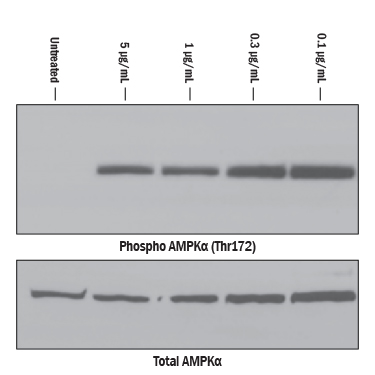Recombinant Human CTRP2/C1qTNF2 Protein, CF Summary
Product Specifications
| DYKDDDDK (FLAG tag) |
Human CTRP2/C1qTNF2 (Gly144-Val285) Accession # Q9BXJ5 |
GGGGS | Human CTRP2/C1qTNF2 (Gly144-Val285) Accession # Q9BXJ5 |
GGGGS | Human CTRP2/C1qTNF2 (Gly144-Val285) Accession # Q9BXJ5 |
| N-terminus | C-terminus | ||||
Analysis
Product Datasheets
Carrier Free
CF stands for Carrier Free (CF). We typically add Bovine Serum Albumin (BSA) as a carrier protein to our recombinant proteins. Adding a carrier protein enhances protein stability, increases shelf-life, and allows the recombinant protein to be stored at a more dilute concentration. The carrier free version does not contain BSA.
In general, we advise purchasing the recombinant protein with BSA for use in cell or tissue culture, or as an ELISA standard. In contrast, the carrier free protein is recommended for applications, in which the presence of BSA could interfere.
9436-TN
| Formulation | Lyophilized from a 0.2 μm filtered solution in HEPES and NaCl. |
| Reconstitution | Reconstitute at 200 μg/mL in PBS. |
| Shipping | The product is shipped at ambient temperature. Upon receipt, store it immediately at the temperature recommended below. |
| Stability & Storage: | Use a manual defrost freezer and avoid repeated freeze-thaw cycles.
|
Scientific Data
 View Larger
View Larger
Recombinant Human CTRP2/C1qTNF2 Induces Phosphorylation of AMPK in C2C12 Differentiated Myocytes. C2C12 differentiated myocytes were treated with Recombinant Human CTRP2/C1qTNF2 (Catalog # 9436-TN) for 1 hour prior to Western blot analysis.
Reconstitution Calculator
Background: CTRP2/C1qTNF2
Complement C1q tumor necrosis factor-related protein 2 (C1qTNF2), also known as CTRP-2 or zacrp2 is an approximately 30 kDa member of the C1q family of secreted proteins (1, 2). Like other members of that family, CTRP2 contains a collagen-like region and one C1q-like domain (3). CTRP2 shares 42% amino acids identity with adiponectin at the presumed functional globular domain (4) and is expressed in stromal vascular cells (5). CTRP2 circulates as a trimeric glycoprotein in plasma (6), and can also form homo-oligomer or hetero-oligomer with other CTRPs (7). C1qTNF2 has been shown to phosphorylate AMPK and ACC in skeletal muscle leading to an increase in glycogen accumulation and fatty acid oxidation (8). C1qTNFs are of clinical interest as diagnostic or therapeutic targets in diseases where energy homeostasis is unbalanced such as obesity, insulin resistance, and type 2 diabetes (2).
- Hosszu, K.K. et al. (2012) Front. Immunol. 5:3.
- Seldin, M.M. et al. (2014) Rev. Endocr. Metab. Disord. 15:111.
- Kim, K.-Y. et al. (2006) FEBS Lett. 580:3953.
- Wong, G.W et al. (2004). Proc. Natl. Acad. Sci. U.S.A. 101:10302.
- Schäffler, A. et al. (2012) Trends in Endocrinology and Metabolism. 23:194.
- Wong, G.W. et al. (2008) Biochem J. 416:161.
- Peterson, J.M.l. et al. (2014) PLOS one 9:e88535.
- Schäffler, A. et al. 2007) Trends in Immunology 28:393.
FAQs
No product specific FAQs exist for this product, however you may
View all Proteins and Enzyme FAQsReviews for Recombinant Human CTRP2/C1qTNF2 Protein, CF
There are currently no reviews for this product. Be the first to review Recombinant Human CTRP2/C1qTNF2 Protein, CF and earn rewards!
Have you used Recombinant Human CTRP2/C1qTNF2 Protein, CF?
Submit a review and receive an Amazon gift card.
$25/€18/£15/$25CAN/¥75 Yuan/¥1250 Yen for a review with an image
$10/€7/£6/$10 CAD/¥70 Yuan/¥1110 Yen for a review without an image
